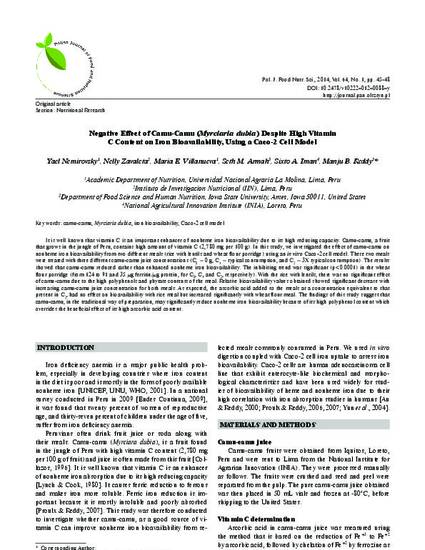
Article
Negative Effect of Camu-Camu (Myrciaria dubia) Despite High Vitamin C Content on Iron Bioavailability, Using a Caco-2 Cell Model
Polish Journal of Food and Nutrition Sciences
Document Type
Article
Disciplines
Publication Date
1-1-2014
DOI
10.2478/v10222–012–0088–y
Abstract
It is well known that vitamin C is an important enhancer of nonheme iron bioavailability due to its high reducing capacity. Camu-camu, a fruit that grows in the jungle of Peru, contains high amount of vitamin C (2,780 mg per 100 g). In this study, we investigated the effect of camu-camu on nonheme iron bioavailability from two different meals (rice with lentils and wheat flour porridge) using an in vitro Caco-2 cell model. These two meals were treated with three different camu-camu juice concentrations (C0 = 0 g, C1 = typical consumption, and C2 = 3X typical consumption). The results showed that camu-camu reduced rather than enhanced nonheme iron bioavailability. The inhibiting trend was significant (p
Rights
Creative Commons Attribution-Non-Commercial-NoDerivs license
Copyright Owner
Institute of Animal Reproduction and Food Research of the Polish Academy of Sciences
Copyright Date
2014
Language
en
File Format
application/pdf
Citation Information
Yael Nemirovsky, Nelly Zavaleta, Maria E. Villanueva, Seth M. Armah, et al.. "Negative Effect of Camu-Camu (Myrciaria dubia) Despite High Vitamin C Content on Iron Bioavailability, Using a Caco-2 Cell Model" Polish Journal of Food and Nutrition Sciences Vol. 64 Iss. 1 (2014) p. 45 - 48 Available at: http://works.bepress.com/manju_reddy/20/

This article from Polish Journal of Food and Nutrition Sciences 64(1) 2014: 45, doi: 10.2478/v10222–012–0088–y Posted with permission.